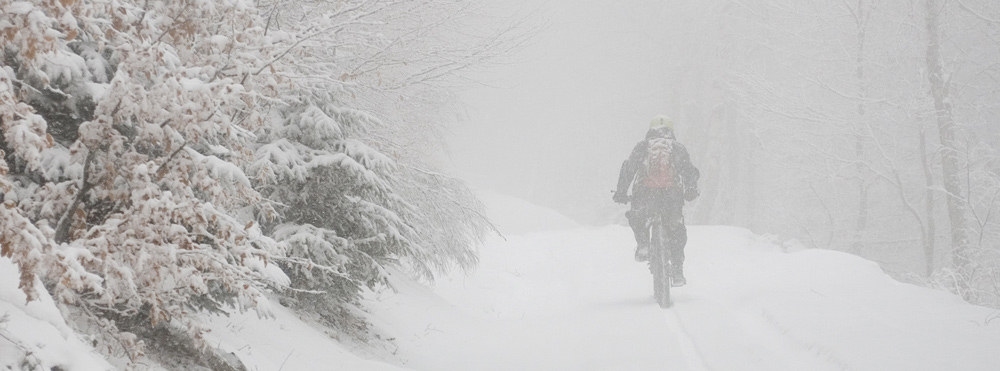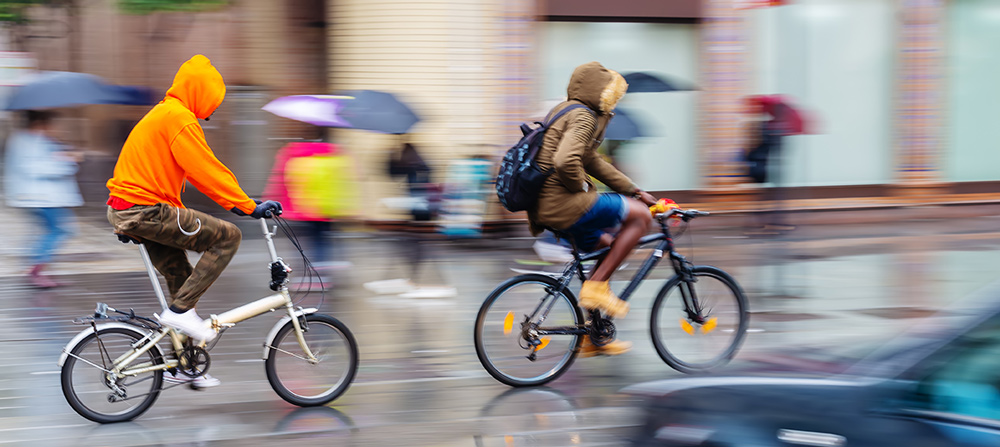For some people, e-bikes are a fun hobby. For others, they are an essential mode of transportation. Whether you use your e-bike to get to work, visit friends, or explore scenic areas around your neighbourhood, you don’t need to stash it away as soon as the first snow of the season arrives. Learn how to ride e-bikes in winter.
With these tips, you can safely enjoy your e-bike even during the coldest months of the year.
Related article: Tips for riding your e-bike in Canadian winter
#1: Know Your Abilities
Winter conditions can be dangerous and unpredictable, catching even the most experienced e-bikers off-guard at times. Before you head out into the snow, it is worthwhile to consider your personal abilities and how they stack up against the risks of riding in winter.
Some considerations include the following:
- If you are new to e-biking, try out your bike in fair weather conditions before attempting to ride when it is icy and snowy. This will build up your confidence and let you get a feel for how your bike handles before taking on more dangerous riding.
- If you are recovering from an injury, your ability to balance on a bike may be impacted. You may also run the risk of aggravating the injury with the repetitive motion of peddling or re-injuring yourself with a fall.
- Illness or medication can affect your ability to safely use an e-bike, especially in poor winter conditions. Medical conditions causing drowsiness or loss of balance should be taken into consideration before riding an e-bike in any weather.
Similarly, riding e-bikes in winter should not be done while drinking or under the influence of any drugs no matter what the weather conditions are.

#2: Know Your E-Bike
Before you try to use your e-bike during the winter, it’s important that you first get used to it under good weather conditions.. Rain, snow and ice are not ideal conditions for testing the limits of what your bike can do.
Specifically, you should get a feel for how fast your bike can go, how the throttle control works, and how the bike responds to braking. You should also know the range of your battery to avoid getting stuck without power in the middle of icy temperatures.
Once you know how your e-bike performs, you will be able to plan your winter rides. If this is your first time using your e-bike in the winter, plan conservatively. Most e-bikes lose about 15% of their range in very cold weather, and the throttle and brakes can behave differently in the snow and ice as well.
Front-wheel-drive bikes have better traction in the snow than rear-wheel-drive bikes. Make sure you know whether your e-bike is front- or rear-wheel-drive and adjust your winter riding techniques accordingly.
Naturally, it will take you longer to get to your destination in the winter than it would in the summer due to how the bike handles differently and the caution needed when taking icy roads. Until you have a solid idea of how your e-bike handles in the winter, leave yourself plenty of time to get to scheduled appointments.
#3: Winterize Your E-Bike
Before taking your e-bike out in the winter, there are things you should do to make it safer and more comfortable.
- Thoroughly check all components of your bike to ensure everything is in working order. This includes the lights, brakes and gears.
- When riding E-bikes in winter, it is good to know that e-bikes are designed to withstand exposure to water in the form of rain and splashes, but the batteries are not fond of cold weather. A neoprene cover will protect your battery from sub-zero temperatures.
- Invest in a rust prevention product that you can spray onto all exposed metal, including the spokes and spoke nipples. This will protect your bike from harsh road salt that can spray up during your rides. If you do use a rust prevention product, don’t let it come into contact with your LCD screen and electronic components.
- One of the most important things you can do is switch out your regular all-season tires for a good pair of winter tires. Not only do winter tires give you better traction in snow and ice, but they are also more durable than regular tires, and less prone to being punctured by the debris that accompanies winter weather. If you anticipate using your e-bike in a variety of winter conditions, it would be advisable to get snow tires for deep, soft snow and studded tires for ice and hard-packed surfaces such as plowed streets.

- The ability to brake effectively is especially important in the winter. The start of the winter season is a great time to change your brake pads and ensure that your brakes are tuned up. At the same time, check your brake cables and make sure there are no areas in which water can collect and freeze.
- Lower your seat to keep your feet closer to the ground. The only thing that is predictable about winter riding is its unpredictability: a lower seat will help you maintain your balance if you hit an icy patch, and will make it easier for you to quickly put your legs out to avoid falling.
- If you are using e-bikes in water for daily commuting, you will encounter a variety of weather conditions Consider installing a fender to prevent snow and slush from splashing up into your face and onto your clothing.
- Put strips of anti-slip tape to your brake and gear controls to prevent your hands from slipping at inopportune moments.
Related article: Are Ebikes Accident-Free: Tips For Ebike Safety
#4: Take Care of Your Battery
Your battery is the heart of your e-bike, and it is imperative that you take proper care of it throughout the winter months. You should expect to have lower-than-usual power and range when riding in sub-zero temperatures. Between rides, you should keep the battery indoors to prevent it from getting too cold.
How you charge your battery matters. If you charge it immediately after a ride, when it is cold, you risk damaging the cells. Instead, bring the battery indoors when you get to your destination, and allow it to slowly warm up to room temperature before you charge it. The battery should never be warmed up by being placed beside a heater.
When your battery is charged and you are ready to put it back on for your next ride, first ensure that the battery terminals are dry and free of snow. This is where your neoprene cover comes in handy as it will help keep in the heat and extend the range.
#5: Keep Your Bike Clean
In most places that experience snow and ice during the winter, salt is used to keep the roads safe for use by motorists and cyclists. The salt can spray up onto your e-bike and can cause the metal parts of your bike to start rusting.
You can prevent this by wiping down your bike regularly to get rid of salt residue, and by applying a bike lubricant to the chain. You can also use a garden spray attachment to wash your e-bike, although this should only be done when the temperature is above zero to prevent the water from freezing.

#6: Wear the Right Clothing
Dressing properly for winter e-biking can be a challenge. Wearing too few layers can leave you feeling unprotected, but too many layers can cause you to sweat which will make you feel colder. Therefore, it is best to select clothing that combines warmth, waterproofing and breathability.
Some of the essential gear for winter e-biking includes the following:
- Helmet. This is required by law in most places and provides essential head protection. Winter conditions create a higher risk of falls and accidents, and a good helmet can literally be a life-saver.
- Gloves. When you are using e-bikes in winter, your hands are exposed. Without gloves, biking will be uncomfortable and potentially dangerous, as extremities are prone to frostbite and numbing. Two-layer gloves are the best option for winter riding – the inner layer provides warmth, while the outer layer provides grip.
- Sunglasses. A pair of anti-glare sunglasses will aid visibility on sunny days and protect your eyes from debris that sprays up from the road. They will also combat snow blindness on days when the sun is shining brightly on a fresh layer of white snow.
- Balaclava. When the wind chill is high, your face can get unbearably cold. A face mask or balaclava can protect you from wind and rain, and make you feel infinitely more comfortable while you ride. Select one made of breathable fabric that will also help keep your neck warm.
- A windproof layer. Putting on warm clothing does not serve any purpose if the warmth escapes as soon as you walk outside. A windproof pair of pants and a windbreaker jacket will ensure that a layer of warmth is kept in.
- Waterproof shoes. There are few things worse in winter than wet, cold feet. Thermal socks combined with waterproof shoes will keep you comfortable and dry.
#7: Be Safe!
One of the most important things to remember during winter e-biking is that you are part of the traffic flow in potentially dangerous conditions. Your e-bike is not the only thing that handles differently in snow and ice: all the vehicles around you have reduced braking ability and a tendency to slide.
Here are some other things you can do to maximize your personal safety while biking in winter conditions:
- Wear bright colours and reflective clothing to ensure that you are visible to fellow road-users
- Install flashing lights and reflective tape on your bike
- Install a rear-view mirror
- Slow down, especially when taking corners, and allow for longer braking times
- If you are riding in the late afternoon or evening, select a well-lit route that is not isolated
- Make sure someone knows what your route is and ensure that your mobile phone is fully charged in case you need to call for help.
Conclusion
While e-biking can be a great year-round hobby and mode of transportation, winter riding requires extra planning and safety. It is also important to remember that an e-bike is a motorized vehicle and you need to take many of the same precautions you would when driving a car.
If local authorities are warning people to avoid driving because of black ice, freezing rain or blizzards, this should be considered a warning for e-bikes as well. However, with extra care, you can still enjoy riding e-bikes in winter and all throughout the year.
Related article: Using an E-bike in Canada: Safety Tips and Precautions




















